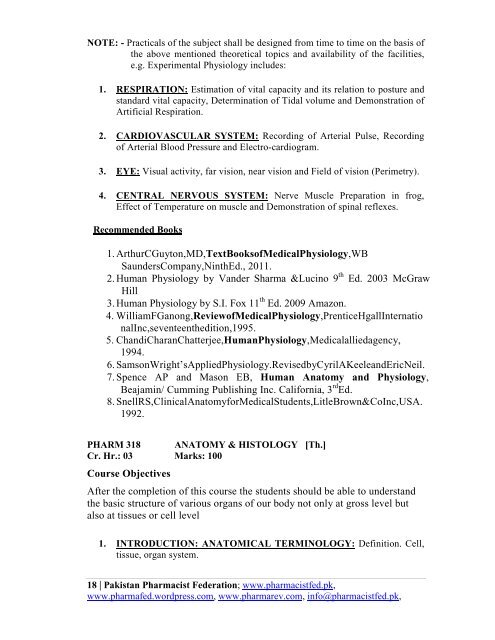Download Pharmacy Curriculum Draft (NCRC); 2011
Download Pharmacy Curriculum Draft (NCRC); 2011 Download Pharmacy Curriculum Draft (NCRC); 2011
NOTE: - Practicals of the subject shall be designed from time to time on the basis ofthe above mentioned theoretical topics and availability of the facilities,e.g. Experimental Physiology includes:1. RESPIRATION: Estimation of vital capacity and its relation to posture andstandard vital capacity, Determination of Tidal volume and Demonstration ofArtificial Respiration.2. CARDIOVASCULAR SYSTEM: Recording of Arterial Pulse, Recordingof Arterial Blood Pressure and Electro-cardiogram.3. EYE: Visual activity, far vision, near vision and Field of vision (Perimetry).4. CENTRAL NERVOUS SYSTEM: Nerve Muscle Preparation in frog,Effect of Temperature on muscle and Demonstration of spinal reflexes.Recommended Books1. ArthurCGuyton,MD,TextBooksofMedicalPhysiology,WBSaundersCompany,NinthEd., 2011.2. Human Physiology by Vander Sharma &Lucino 9 th Ed. 2003 McGrawHill3. Human Physiology by S.I. Fox 11 th Ed. 2009 Amazon.4. WilliamFGanong,ReviewofMedicalPhysiology,PrenticeHgallInternationalInc,seventeenthedition,1995.5. ChandiCharanChatterjee,HumanPhysiology,Medicalalliedagency,1994.6. SamsonWright’sAppliedPhysiology.RevisedbyCyrilAKeeleandEricNeil.7. Spence AP and Mason EB, Human Anatomy and Physiology,Beajamin/ Cumming Publishing Inc. California, 3 rd Ed.8. SnellRS,ClinicalAnatomyforMedicalStudents,LitleBrown&CoInc,USA.1992.PHARM 318 ANATOMY & HISTOLOGY [Th.]Cr. Hr.: 03 Marks: 100Course ObjectivesAfter the completion of this course the students should be able to understandthe basic structure of various organs of our body not only at gross level butalso at tissues or cell level1. INTRODUCTION: ANATOMICAL TERMINOLOGY: Definition. Cell,tissue, organ system.18 | Pakistan Pharmacist Federation; www.pharmacistfed.pk,www.pharmafed.wordpress.com, www.pharmarev.com, info@pharmacistfed.pk,
2. STRUCTURE OF CELL: Cell Membrane. Cytoplasm. Organcelles.Nucleus. Cell cycle.3. TISSUES OF BODY:Types of tissues with examplesa. Epithelial Tissue: General characters, classification.b. Connective Tissue: Structure, types (Connective tissue Cartilage. Bonesstructure and types of bones and joints). Muscle:c. Structure of — skeletal muscle, Smooth muscle, muscle.4. INTEGUMENTARY SYSTEM:(a) Skin — Structure (Epidermis, dermis).(b) Glands of Skin, (Sweat, Sebaceous).(c) Hair — Structure, function.(d) Nail.5. CARDIOVASCULAR SYSTEM:(a) Heart — Structure of Heart. Location of Heart. Blood Supply to Heart.(b) Blood Vessels — Main blood vessels arising & entering theheart.Types of blood vessels with examples.6. ELEMENTARY SYSTEM: Name and structure of different parts ofelementary system and their inter relationship.7. URINARY SYSTEM: Name and structure of organs of urinary system andtheir inter-relationship.8. REPRODUCTIVE SYSTEM: Male ande Female reproductive systems.Name, structure and association of the organs.9. ENDOCRINE SYSTEM:(a) Pituitary gland — structure and relation to hypothalamus.(b) Thyroid gland — structure.(c) Adrenal gland — structure.10.NERVOUS SYSTEM: Introduction: Cells of Nervous System (Neuron),Accessory cells of N.S. and Organization of N.S.(a) Brain — Meninges (Cerebrum — cerebral Lobes. Ventricals,Cerebellum—Anatomy of Cerebellum, Brain Stem — MidBrain. Pons.Medulla Oblongata, Diencephalon. Thalamus Hypothalamus andCranial Nerves).(b) Spinal Cord — Meninges (C.S.F. Internal Structure, Sensory andMotor Pathway, Spinal Reflexes, Peripheral spinal Nerves, AutonomicNervous System includes Sympathetic N.S. and ParasympatheticNervous System).HISTOLOGY:(a) Underlying principles of histological techniques and staining specifictissues should be explained.(b) Staining of paraffin and frozen sections will be given to the students.19 | Pakistan Pharmacist Federation; www.pharmacistfed.pk,www.pharmafed.wordpress.com, www.pharmarev.com, info@pharmacistfed.pk,
- Page 1 and 2: NATIONAL CURRICULUM REVISIONCOMMITT
- Page 5 and 6: The aims and objectives of Doctor o
- Page 7 and 8: 14. To prepare pharmacy graduates f
- Page 9 and 10: and its Applications in Pharmacy)[L
- Page 11 and 12: DETAILS OF COURSES ( SEMESTER SYSTE
- Page 13 and 14: PHARM 311 PHARMACEUTICS-I (Physical
- Page 15 and 16: 9. Naser-ud-Din, Introduction to St
- Page 17: Expression of Genetic Information,
- Page 21 and 22: Communications SkillsObjectives: En
- Page 23 and 24: Experiments to demonstrate some of
- Page 25 and 26: 1990.9. Naser-ud-Din, Introduction
- Page 27 and 28: Hemorrhage and Other Causes of Hypo
- Page 29 and 30: IS 402ISLAMIC STUDIESCr. Hr.: 01 Ma
- Page 31 and 32: Publications New Delhi (1989)9) Dr.
- Page 33 and 34: PHARM 413 PHARMACEUTICS-V (Pharmace
- Page 35 and 36: e. Drug treatment of chronic inflam
- Page 37 and 38: j. Labiatae Peppermint, Thyme, Spea
- Page 39 and 40: SECOND SEMESTERPS 403PAKISTAN STUDI
- Page 41 and 42: NOTE:- Practicals of the subject sh
- Page 43 and 44: i. Drugs used for cough (Anti-tussi
- Page 45 and 46: 1. Drugs of Animal OriginGeneral in
- Page 47 and 48: Frequency Table, Diagrams, Pictogra
- Page 49 and 50: pharmaceutical students Churchill L
- Page 51 and 52: anaesthetic drugs on human and the
- Page 53 and 54: 5. Plant SteroidsIntroduction, extr
- Page 55 and 56: Adenoma, Chondroma, Fibroma, Leomyo
- Page 57 and 58: Aluminium Hydroxide, Ammonium Chlor
- Page 59 and 60: of frog. To demonstrate the effects
- Page 61 and 62: 6. Tumor Inhibitors from PlantsIntr
- Page 63 and 64: • Components of a Computer• Com
- Page 65 and 66: 1. INTRODUCTION(a) Role of Pharmaci
- Page 67 and 68: withdrawal, Detection, Management o
NOTE: - Practicals of the subject shall be designed from time to time on the basis ofthe above mentioned theoretical topics and availability of the facilities,e.g. Experimental Physiology includes:1. RESPIRATION: Estimation of vital capacity and its relation to posture andstandard vital capacity, Determination of Tidal volume and Demonstration ofArtificial Respiration.2. CARDIOVASCULAR SYSTEM: Recording of Arterial Pulse, Recordingof Arterial Blood Pressure and Electro-cardiogram.3. EYE: Visual activity, far vision, near vision and Field of vision (Perimetry).4. CENTRAL NERVOUS SYSTEM: Nerve Muscle Preparation in frog,Effect of Temperature on muscle and Demonstration of spinal reflexes.Recommended Books1. ArthurCGuyton,MD,TextBooksofMedicalPhysiology,WBSaundersCompany,NinthEd., <strong>2011</strong>.2. Human Physiology by Vander Sharma &Lucino 9 th Ed. 2003 McGrawHill3. Human Physiology by S.I. Fox 11 th Ed. 2009 Amazon.4. WilliamFGanong,ReviewofMedicalPhysiology,PrenticeHgallInternationalInc,seventeenthedition,1995.5. ChandiCharanChatterjee,HumanPhysiology,Medicalalliedagency,1994.6. SamsonWright’sAppliedPhysiology.RevisedbyCyrilAKeeleandEricNeil.7. Spence AP and Mason EB, Human Anatomy and Physiology,Beajamin/ Cumming Publishing Inc. California, 3 rd Ed.8. SnellRS,ClinicalAnatomyforMedicalStudents,LitleBrown&CoInc,USA.1992.PHARM 318 ANATOMY & HISTOLOGY [Th.]Cr. Hr.: 03 Marks: 100Course ObjectivesAfter the completion of this course the students should be able to understandthe basic structure of various organs of our body not only at gross level butalso at tissues or cell level1. INTRODUCTION: ANATOMICAL TERMINOLOGY: Definition. Cell,tissue, organ system.18 | Pakistan Pharmacist Federation; www.pharmacistfed.pk,www.pharmafed.wordpress.com, www.pharmarev.com, info@pharmacistfed.pk,



